biology - key concepts in biology (1.1 - 1.17)
1/31
There's no tags or description
Looks like no tags are added yet.
Name | Mastery | Learn | Test | Matching | Spaced |
|---|
No study sessions yet.
32 Terms
1.1 animal cells - sub-cellular structures (4) & functions
nucleus: controls cell; contains chromosomes
cell membrane: controls what enters & leaves
mitochondria: site of aerobic respiration; provide energy
ribosomes: site of protein synthesis
1.1 plant cells - sub-cellular structures (7) & functions
nucleus: controls cell; contains chromosomes
cell membrane: controls what enters & leaves
cell wall: made of cellulose; supports & protects
chloroplasts: site of photosynthesis; contain chlorophyll - traps energy transferred from sun for photosynthesis
mitochondria: site of aerobic respiration; provide energy
ribosomes: site of protein synthesis
vacuole: stores cell sap; keeps cell firm & rigid
1.1 bacteria - sub-cellular structures (5) & functions
chromosomal DNA: controls most of cell’s activities
plasmid DNA: controls a few of cell’s activities
cell membrane: controls what enters & leaves
ribosomes: site of protein synthesis
flagella: allows cell to move
1.2 sperm cells - adapted to function
acrosome: contains enzymes that break down egg’s cell membrane - sperm can penetrate egg
haploid nucleus: 23 chromosomes - cell produced by fertilisation has 2 copies of each chromosome
mitochondria: lots - release lots of energy to power tail
tail: allows cell to swim
1.2 egg cells - adapted to function
nutrients in cytoplasm: supplies fertilised egg cell for growth of embryo
haploid nucleus: 23 chromosomes - cell produced by fertilisation has 2 copies of each chromosome
changes in cell membrane after fertilisation: cell membrane becomes hard - stops other sperm cells entering
1.2 ciliated epithelial cells - adapted to function
cilia: sweep substances along
resolution definition
smallest distance between 2 distinguishable points
1.3 development of microscope technology
higher resolution & magnification
see cell structures & organelles with more clarity & detail
understand role of sub-cellular structures better
electron microscope - beams of electrons pass through specimen, build up image
how to find magnification of microscope
multiply magnifications of 2 lenses
e.g. eyepiece lens: x5; objective lens: x10 → 5 × 10 = x50
1.5 SI units
millimetres (mm): x10-3
micrometres (µm): x10-6
nanometres (nm): x10-9
picometres (pm): x10-12
1.6 core practical: investigate biological specimens using microscopes
collect small specimen of cells
add drop water/stain to centre of microscope slide
place specimen on drop of water/stain
use toothpick to slowly lower coverslip onto specimen
examine specimen under microscope - start with lowest magnification
draw cells seen & annotate drawing
1.7 enzyme action
active site: where substrate of enzyme fits at start of reaction
enzymes only works with specific substrates that fit active site
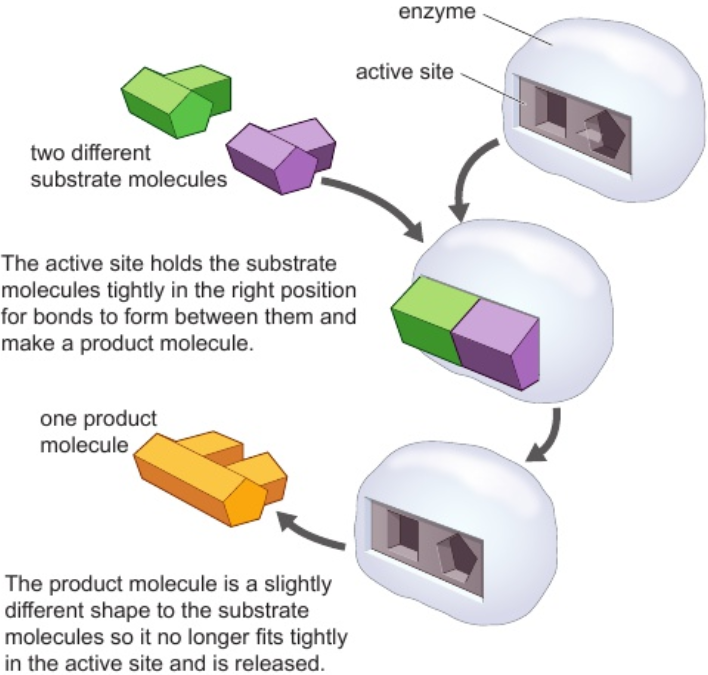
1.8 enzymes denatured
changes in pH/temp. - affect how protein folds → affect active site shape
active site shape changes too much - substrate doesn’t fit, enzyme won’t catalyse reaction, enzyme denatured
1.9 effect of temperature on enzyme activity
temp. increases - molecules move faster, more frequent successful collisions between substrate & enzyme molecules
temp. too high - active site shape starts to change (amount of change increases as temp. increases), increasingly difficult for substrate molecule to fit into active site
optimum temp.: temp. enzyme works fastest at
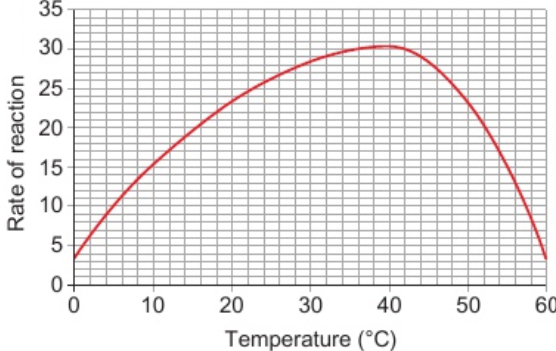
1.9 effect of substrate concentration on enzyme activity
high conc. - most enzyme active sites contain substrate molecules, rate of reaction fastest it can be
low conc. - many enzyme active sites are empty, low rate of reaction
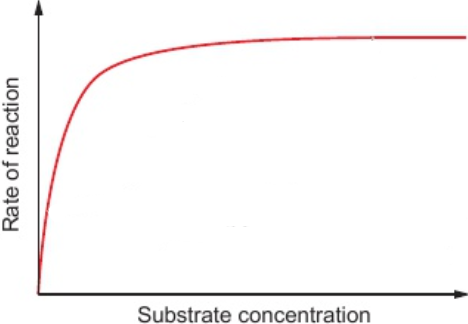
1.9 effect of pH on enzyme activity
pHs below & above optimum - active site shape affected, enzyme doesn’t work as well
optimum pH: pH enzyme works best at

1.10 core practical: investigate effect of pH on enzyme activity
set up heating apparatus: tripod; gauze; heat-resistant mat; Bunsen burner; large beaker half-filled with water
heat water to 40°C & keep it at this temp.
place 1 drop iodine solution in each depression of dimple tile
measure 2cm3 amylase solution into tube
add 1cm3 solution with particular pH to tube
add 2cm3 starch solution to tube & place in water bath, start stop clock & stir mixture
every 20 secs, place 1 of mixture drop into fresh drop of iodine solution; stop testing when iodine solution stops changing colour
repeat experiment using diff. pH solution in step 5
shortest time to digest substrate = enzyme’s optimum pH
1.11 rate calculations for enzyme activity
amount of substrate broken down/time
amount of product formed/time
e.g. 100g starch broken down in 5 min → 100/5 = 20g/min
1.12 importance of enzymes as biological catalysts - food molecules
digestive enzymes - large molecules (food) → small subunits
digested molecules small enough for absorption by small intestine - used to build larger molecules cells & tissues needed
synthesis
building larger molecules from smaller subunits
1.12 importance of enzymes as biological catalysts - time
breakdown of large molecules very slow - only if bonds between small subunits have enough energy to break
synthesis very slow - subunits rarely collide with energy force/right orientation to form bond
too slow to supply all body needs & keep it alive
enzymes speed up reactions needed to stay alive
biological catalyst
speeds up reactions without being changed itself
1.12 what does protein break down into?
protein → amino acids
1.12 what does starch break down into?
starch → glucose molecules
1.12 what do lipids break down into?
lipid → fatty acids & glycerol
1.13 core practical: food tests

1.14 measuring energy contained in food using calorimetry
burn in calorimeter - measures energy taken in & given out in chemical reaction
amount of energy transferred from burning food → water - calculated from increase in water temp.
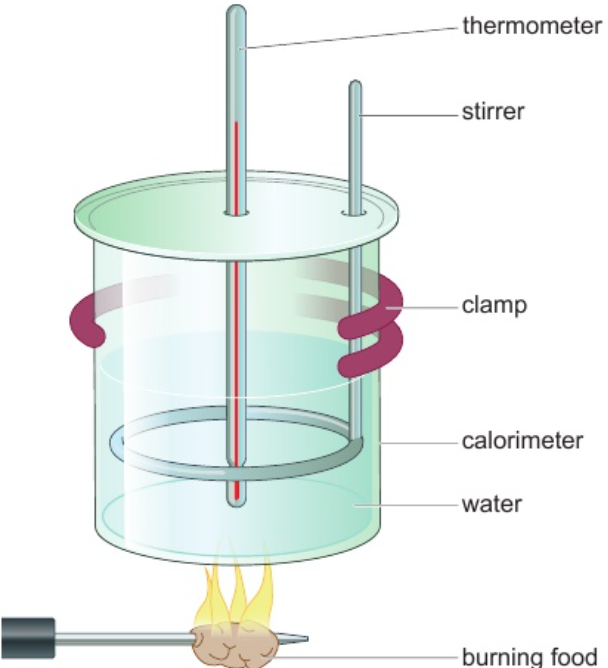
1.15 diffusion
movement of particles from area of high concentration → area of low concentration
particles diffuse down concentration gradient
steeper conc. gradient = faster diffusion
1.15 osmosis
movement of water molecules across semi-permeable membrane from area of high water conc. → area of low water conc.
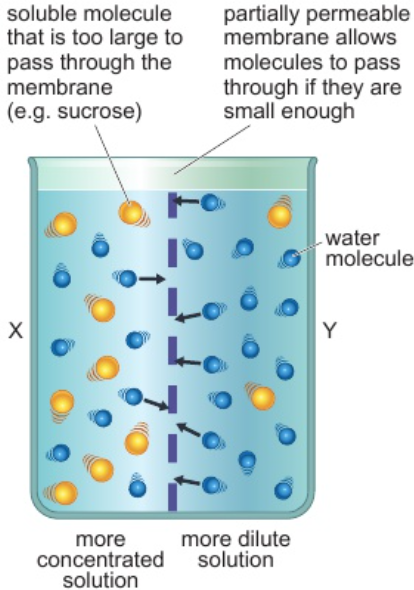
1.15 active transport
movement of particles across cell membrane from area of low conc. → area of high conc. requiring energy from cellular resp.
by transport proteins in cell membranes
1.16 core practical: osmosis in potatoes
label diff. boiling tubes with diff. sucrose conc.
cut same-sized pieces of potato, 1 per tube
blot each potato piece dry; measure & record its mass; put in empty tube
fill each tube with sucrose solution of appropriate conc. (ensure potato is covered)
after at least 15 mins, remove each potato piece & blot dry; measure & record mass
1.16 calculate percentage gain & loss of mass in osmosis
